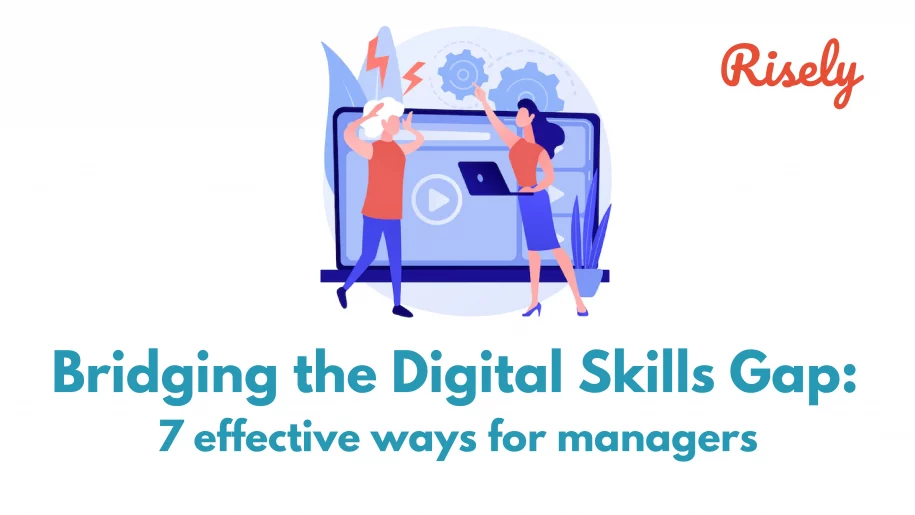Bridging the Digital Skills Gap: 7 effective ways for managers
In today’s digital age, having the right skills can make all the difference in your career. But what exactly are digital skills? This blog post will delve deeper into what digital skills entail, from basic to advanced levels. We will also discuss the concept of the digital skills gap and why organizations must address this gap. If you’re a manager looking to bridge the technology skills gap within your team, we’ve got you covered with some actionable tips. Additionally, we will provide real-life examples of digital skills in high demand in various industries. So whether you’re an individual looking to upskill or a manager seeking to enhance your team’s capabilities, this blog will equip you with the knowledge and strategies needed to bridge the digital skills gap.What exactly are digital skills?
Digital skills are effectively using digital technologies, tools, and platforms to perform tasks, solve problems, and navigate the digital world. These skills encompass a wide range of abilities, from basic competencies such as operating a computer or using common software applications to more advanced skills like programming, data analysis, and digital marketing.Basic and Advanced digital skills examples
Basic digital skills encompass the foundational competencies to navigate and use digital technologies effectively. These skills are essential for everyday activities and fundamental in today’s digital world. Basic digital skills may include:- Operating a computer and mobile devices.
- Using standard software applications (e.g., word processors, spreadsheets, web browsers).
- Conducting basic internet searches.
- Sending and receiving emails.
- Understanding digital security and privacy practices.
- Programming and coding languages
- Data analysis and visualization
- Web development
- Digital marketing strategies
- Cybersecurity
- Artificial intelligence
- Machine learning
What are the technology skills gap?
The technology skills gap refers to the disparity between the skills and knowledge required by the rapidly evolving technology industry and the skills possessed by the available workforce. As technology advances quickly, developing the skills needed to leverage and work with emerging technologies is often needed. This creates a gap between the demand for skilled technology professionals and the supply of individuals with the necessary expertise. The technology skills gap has implications for both individuals and organizations. Individuals who lack the required technology skills may face challenges in securing employment or career advancement opportunities. On the other hand, organizations may struggle to find and retain qualified professionals, hindering their ability to innovate, adopt new technologies, and remain competitive.5 common technology skills gap in the Workplace
While the specific technology skills gap in the workplace can vary depending on industry and organization, here are five common areas where such gaps are often observed:- Data Analytics and Interpretation: With the increasing importance of data-driven decision-making, organizations require employees who can effectively collect, analyze, and interpret data. However, there is often a skills gap in data analysis, visualization, and extracting meaningful insights from large datasets.
- Cybersecurity: As cyber threats continue to evolve and become more sophisticated, organizations need professionals with strong cybersecurity skills to protect their data, systems, and networks. A significant challenge is the shortage of individuals with expertise in network security, incident response, and vulnerability management.
- Programming and Software Development: Programming skills are crucial for developing software applications, websites, and automation solutions. The demand for programmers and software developers often surpasses the supply, and there is a skills gap in programming languages, frameworks, and development methodologies.
- Cloud Computing and Infrastructure: Cloud computing has become vital to modern IT infrastructure. Organizations require professionals with skills in cloud platforms (e.g., AWS, Azure, Google Cloud) to manage cloud environments, deploy applications, and ensure scalability and reliability. However, the skills gap is often observed in cloud architecture, infrastructure management, and cloud security.
- Digital Marketing and Social Media Management: In the era of online marketing and social media dominance, organizations seek individuals who can navigate digital marketing channels, create effective campaigns, analyze metrics, and manage social media platforms. However, the skills gap may exist in areas such as SEO (Search Engine Optimization), content marketing, social media analytics, and digital advertising.
How can managers reduce the technology skills gap in their team?
Managers are critical in reducing the technology skills gap within their teams. Below are some strategies they can employ. By implementing these strategies, managers can actively contribute to reducing the technology skills gap within their teams, fostering a skilled and capable workforce that can adapt to evolving technological demands and drive organizational success.- Identify Skill Gaps: Managers should assess their team members’ existing skills and competencies to identify areas where there is a technology skills gap. This can be done through skill assessments, performance evaluations, and open communication with team members. Understanding the specific skill gaps will help in designing targeted solutions.
- Training and Development Programs: Managers should prioritize training and development initiatives to enhance the technology skills of their team members. This can involve providing access to relevant online courses, workshops, and seminars or encouraging employees to attend industry conferences and training programs. Additionally, managers can facilitate internal knowledge-sharing sessions, where team members can teach each other new technologies or skills.
- Upskilling and Reskilling Opportunities: In addition to external training, managers should create opportunities for upskilling and reskilling within the team. This can involve assigning team members to projects that require learning new technologies, providing mentorship, or offering job rotation opportunities to gain exposure to different areas. Supporting employees in obtaining certifications or advanced degrees related to technology can also be beneficial.
- Collaboration and Knowledge Sharing: Encouraging collaboration among team members can help bridge technology skills gaps. Managers should create an environment that promotes knowledge sharing and collaboration, where team members can learn from one another’s expertise. This can be facilitated through regular team meetings, cross-functional projects, or establishing communities of practice within the organization.
- External Partnerships and Skill Acquisition: Managers can explore partnerships with external organizations, such as universities, training providers, or industry associations, to address specific technology skills gaps. This can involve organizing joint training programs, internship opportunities, or participating in industry events and conferences. Collaborating with external experts can provide fresh perspectives and insights to enhance the team’s technology skills.
- Continuous Learning Culture: Managers should foster a culture of constant learning within their teams. Encourage and support employees to stay updated with the latest technological advancements through self-learning, subscribing to relevant newsletters or blogs, and participating in online forums or communities. Recognize and reward team members who actively pursue learning opportunities and demonstrate growth in their technology skills.
- Recruiting and Hiring Strategies: Managers should prioritize candidates with the desired technical skills and competencies when hiring new team members. Clear job descriptions and skill requirements should be defined to attract candidates who possess the necessary skills. Additionally, considering candidates with potential and a willingness to learn can help bridge the skills gap over time.
Conclusion
In conclusion, bridging the digital skills gap is crucial for businesses to thrive in today’s digital age. Basic digital skills are essential for everyone to navigate the online world effectively, while advanced digital skills are necessary for professionals to excel in their respective fields. The digital skills gap is the disparity between the demand for digital skills and the available talent pool. Managers play a crucial role in reducing this gap by investing in training and development programs, fostering a culture of continuous learning, and hiring diverse candidates with various digital skills. Organizations must prioritize closing the digital skills gap to stay competitive in the digital landscape. If you want to learn more about specific examples of digital skills or how to develop them within your team, check out our comprehensive guide on bridging the digital skills gap.Grab your free copy of Risely’s skills gap analysis framework now!
Inside you’ll find an easily adaptable template to track the skill needs of your team effectively.
5 Best Leadership Coaching Certification Programs For 2024
5 Best Leadership Coaching Certification Programs For 2024 Leadership coaching has gained significant popularity in recent years as more organizations…
Top 5 ways for Utilizing the Learning Curve Theory for L&D Professionals
Top 5 ways for Utilizing the Learning Curve Theory for L&D Professionals Introduction: Welcome, fellow Learning and Development (L&D) enthusiasts,…
Why Do Managers Need Skill Development And Training? 6 Top Ways
Why Do Managers Need Skill Development And Training? 6 Top Ways Managers in the office have a lot of responsibilities,…
Mastering Multi skilling: Learn about its 3 Types and Pros & Cons
Mastering Multi skilling: Learn about its 3 Types and Pros & Cons In today’s fast-paced world, multiskilling is an essential…
Upskilling Managers and Leaders: 6 Essential Ways for Team Success
Upskilling Managers and Leaders: 6 Essential Ways for Team Success In today’s ever-evolving business world, managers and leaders must keep…
FAQs
What is the digital skills gap?
The digital skills gap refers to the discrepancy between the technology and digital proficiency skills that employers require and the skills the current workforce possesses. This gap can hinder business growth and competitiveness in today’s digital age.
What are the 3 most significant technology skill gaps?
The three most significant technology skill gaps are programming languages, data analysis tools, and web development.
How can the digital skills gap be reduced?
The digital skills gap can be reduced by investing in training and development programs, fostering a culture of continuous learning, and hiring diverse candidates with various digital skills.


